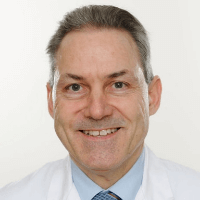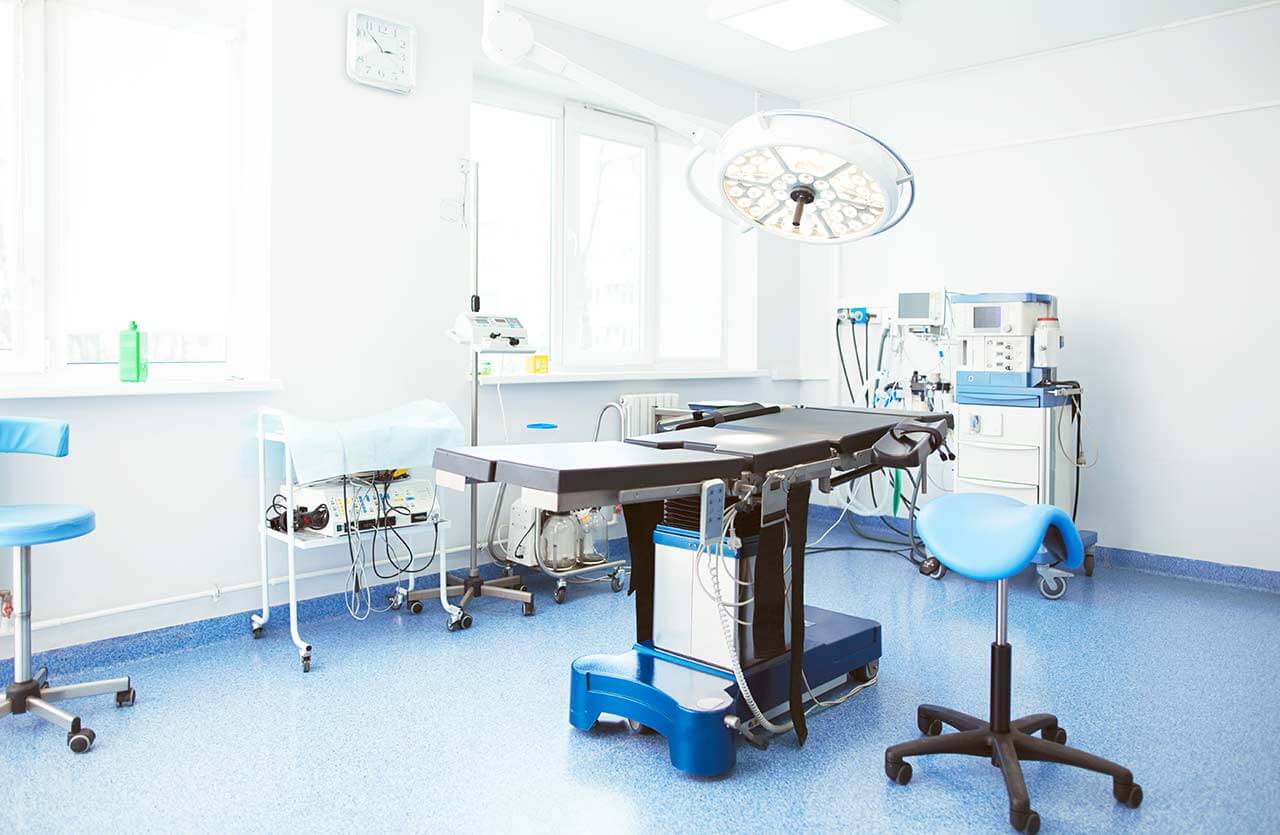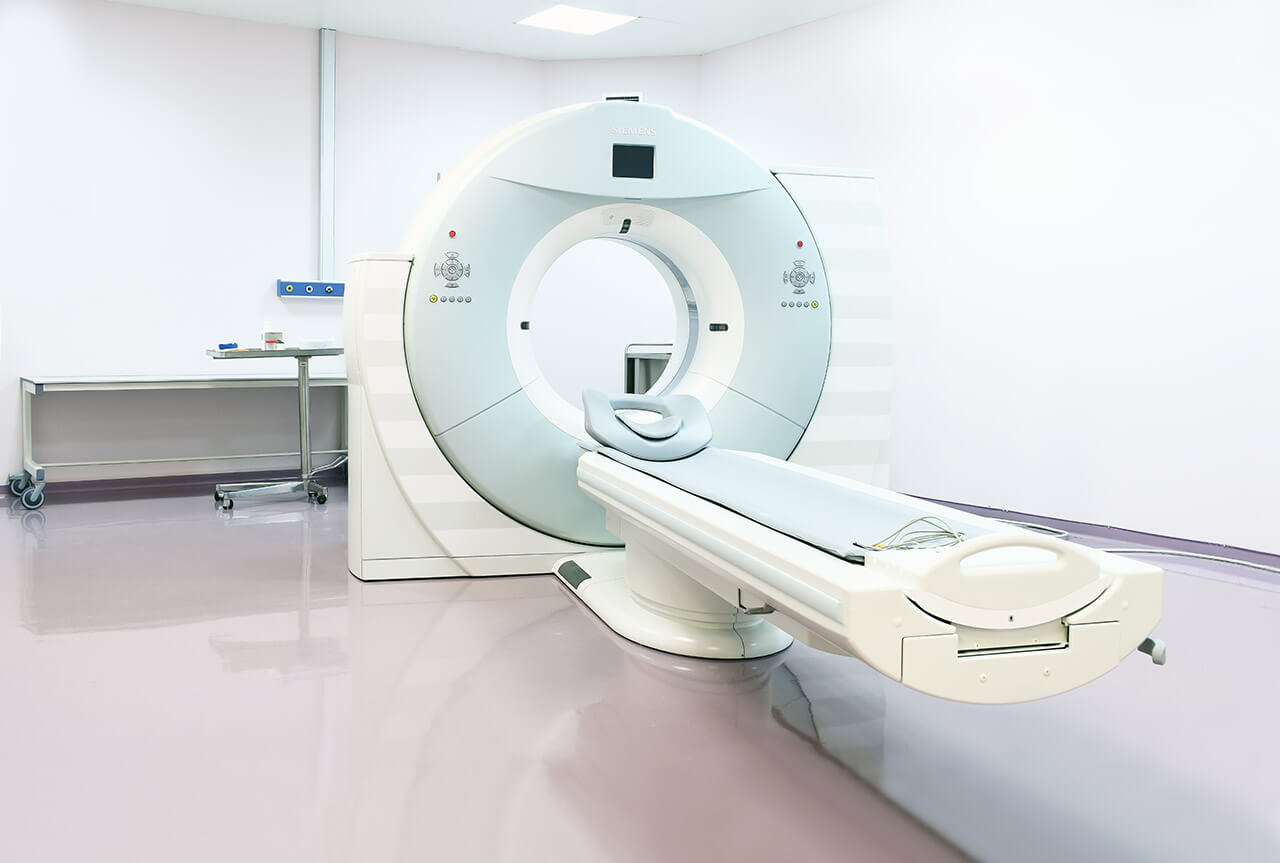
The program includes:
- Initial presentation in the clinic
- clinical history taking
- review of medical records
- physical examination
- laboratory tests:
- complete blood count
- general urine analysis
- biochemical analysis of blood
- TSH-basal, fT3, fT4
- tumor markers
- inflammation indicators (CRP, ESR)
- indicators of blood coagulation
- abdominal ultrasound scan
- CT scan/MRI or PET-CT of abdomen
- preoperative care
- cytoreductive surgery to remove visible tumors
inside the abdomen and HIPEC - histological and immunohistochemical
examination of removed tissues - symptomatic treatment
- cost of essential medicines
- nursing services
- stay in the hospital with a full board
- accommodation in a 2-bedroom ward
- elaboration of further recommendations
How program is carried out
During the first visit, the physician will conduct a clinical examination and go through the results of the available diagnostic tests. After that, you will undergo the necessary additional examination, such as the assessment of liver and kidney function, ultrasound scan and tomography of the abdominal organs. Based on the results of the examination, the physician will choose the surgical technique and the type of anesthesia. After that, preparation according to the preoperative standard will start.
Cytoreductive surgery begins with general anesthesia. The intervention is performed as open surgery, i.e. through the incision in the anterior abdominal wall, so that the surgeon can carefully examine the peritoneum and the surface of the abdominal organs. The surgeon removes affected by the malignant process ovaries, areas of the peritoneum and metastases in other internal organs. This stage of the operation can take several hours, since the overall effectiveness of the treatment depends on the completeness of the malignant tissues removal.
At the next stage of the operation, the surgeon inserts several catheters into the abdominal cavity. Through the catheters, a heated solution of a chemotherapy drug is pumped inside. The special system maintains the required temperature (42-43 degrees Celsius), pressure and circulation rate of the medicinal solution. The solution mechanically flushes out blood clots and remnants of malignant tissues, and a heated chemotherapy drug destroys micrometastases in internal organs and lymph nodes (micrometastases can’t be detected by the naked eye).
After 1-1.5 hours, the chemotherapy drug is removed from the abdominal cavity and the abdominal cavity is washed with saline. After that, the surgeon removes the catheters and sutures the incision of the anterior abdominal wall.
After the completion of the operation, you will be transferred to the ward of the intensive care unit, under the round-the-clock supervision of doctors and nurses. In 1-3 days after the operation, your drains will be removed and you will be transferred to a regular ward for further recovery. The whole treatment takes 10-12 days on average.
Finally, the attending physician will evaluate the results of control examinations, schedule the date of discharge from the hospital and give you detailed recommendations for further follow-up and treatment.
Required documents
- Medical records
- MRI/CT scan (not older than 3 months)
- Biopsy results (if available)
Service
You may also book:
 BookingHealth Price from:
BookingHealth Price from:
About the department
The Department of Gynecologic Oncology at the Hirslanden Clinic Aarau offers the full range of diagnostic and therapeutic services for patients with malignancies of the reproductive organs. The treatment is provided on an interdisciplinary basis, using the very latest and the most effective methods. Prior to any operation, the doctors thoroughly study patient's medical history and carry out the comprehensive diagnostics, after which they individually select the optimal treatment option. The specialists meet Good Clinical Practice standards, due to which the department maintains an exceptionally high level of medical service. The department is headed by Prof. Dr. med. Pius Wyss.
If oncological process is detected in a patient, then she should undergo additional examinations to obtain more detailed information – assessment of the stage of the disease, tumor location, the presence of metastases, etc. With all the diagnostic data, gynecologists hold an interdisciplinary tumor boards, during which they decide on the most effective treatment tactics. In most cases, the treatment basis is surgical resection of the tumor, which, depending on the specific clinical indications, can be supplemented with chemotherapy, radiation therapy, immunotherapy, antihormonal therapy and other therapeutic measures.
The range of the department’s medical services includes:
- Diagnostics and treatment of cancers of the female reproductive organs
- Endometrial cancer
- Minimally invasive surgery with laparoscopic hysterectomy and adnexectomy
- Microscopic tissue examination during surgery, according to the results of which a decision is made on the preservation or removal of lymph nodes in the pelvic area (para-aortic lymphadenectomy)
- Ovarian cancer, tubal cancer and peritoneal cancer
- Standard cancer interventions in collaboration with specialists in abdominal surgery (if necessary, also in collaboration with urologists)
- Cervical cancer
- Laparoscopic extended hysterectomy (if necessary, in combination with adnexectomy or para-aortic lymphadenectomy)
- Vulvar cancer
- Surgical removal of the tumor
- Plastic reconstructive interventions
- Vaginal cancer
- Surgical removal of the tumor
- Primary radiation therapy
- Endometrial cancer
- Minimally invasive gynecologic surgery
- Treatment of benign tumors (for example, uterine fibroids)
- Diagnostic and therapeutic hysteroscopy
- Laparoscopic assessment of fallopian tube patency
- Cervical conization for dysplasia
- Other surgical options
Curriculum vitae
Clinical Interests
- Gynecologic surgery with a special focus on cancer surgery.
- Breast cancer surgery (including breast reduction surgery and reconstructive plastic surgery).
- Laparoscopic and hysteroscopic surgery.
- Pelvic surgery.
Professional Career
- 2001 - 2004 Deputy Head of the Department of Gynecology at the University Hospital Zurich.
- 1999 - 2000 Leading Physician of the Department of Gynecology at the University Hospital Zurich.
- 1998 Senior Physician, Habilitation in Gynecology and PD Title, University of Zurich.
- 1996 - 1998 Senior Physician, Training in Health Management, University of Zurich.
- 1994 - 1998 Senior Physician, Department of Gynecology, University Hospital Zurich.
- 1993 Research Internship in Photodynamic Laser Therapy, Beckman Laser Institute, University of California, Irvine, USA.
- 1992 Senior Physician, Department of Gynecology and Obstetrics, District Hospital Lachen.
- 1989 - 1991 Assistant Physician, Department of Gynecology, University Hospital Zurich.
- 1988 Assistant Physician, Department of Abdominal and Gynecologic Surgery, Centre Hospitalier Princesse Grace, Monaco.
- 1986 - 1987 Assistant Physician, Department of Surgery, Cantonal Hospital Lucerne.
- 1985 Assistant Physician, Department of Surgery, Hospital Triemli.
- 1983 - 1984 Assistant Physician, teaching and research activities, Institute of Anatomy at the University of Zurich.
Higher Education
- 1983 Doctorate in Medicine.
- 1982 State Medical Exam.
- 1978 - 1982 Faculty of Medicine, University of Zurich.
- 1976 - 1978 Study of Human Medicine at the Faculty of Medicine at the University of Fribourg.
Memberships in Professional Societies
- Society of Physicians of the Canton of Zürich (AGZ).
- Swiss Medical Association (FMH).
- Swiss Society of Gynecology and Obstetrics.
Photo of the doctor: (c) Hirslanden AG
About hospital
The Hirslanden Clinic Aarau enjoys the status of one of the largest and most successful private medical facilities in Bern and Zurich. The clinic is part of the Hirslanden Network known in Europe, which is a provider of first-class medical services in Switzerland.
The main areas of specialization of the clinic in Aarau include cardiology, cardiac surgery, abdominal surgery, urology, oncology, neurosurgery, spinal surgery and orthopedics. The Department of Obstetrics annually delivers more than 700 babies. The high professionalism of the clinic’s medical staff, as well as the excellent technical base, make it possible to successfully cure not only common pathologies, but also very complex clinical cases.
All efforts of doctors and nursing staff of the clinic are focused on meeting the needs of patients and best possible restoration of their health. The work with patients is based on an individual approach to each clinical situation. The clinic has 155 beds for inpatient treatment. The surgical treatment is provided in 7 operating rooms with all the necessary surgical instruments, computer monitoring systems, navigation devices, robot-assisted systems for sparing laparoscopic operations.
Since 2010, the clinic introduced a unified quality management system, which includes all clinics in the Hirslanden Network. The clinical performance indicators and patient reviews are provided in the annual reports available to all those who want to see them. At the moment, the clinic rating is 8.9 out of 10 possible points – based on patient reviews. The clinic is also the first and only health facility in the canton of Aargau, which medical services were certified in accordance with the new ISO 2016 standards.
Photo: (с) depositphotos
Accommodation in hospital
Patients rooms
The patients of the Hirslanden Clinic Aarau live in cozy rooms equipped with everything necessary for a comfortable stay in the hospital. Each patient room has an ensuite bathroom with shower and toilet. The standard patient room includes an automatically adjustable bed, a bedside table, a wardrobe with lockers for storing personal belongings, a hairdryer, a table and chairs for receiving visitors, a TV and a radio. The patient rooms also have Wi-Fi access. If desired, the patients can live in enhanced-comfort patient rooms, which are additionally equipped with a safe, a refrigerator and upholstered furniture.
Meals and Menus
The patient and the accompanying person are offered a daily choice of three menus. If you are on a specific diet for any reason, you will be offered an individual menu. Please inform the medical staff about your dietary preferences prior to the treatment.
Further details
Standard rooms include:
Religion
The religious services can be provided upon request.
Accompanying person
During the inpatient program, an accompanying person may stay with the patient in the patient room or at a hotel. Our managers will help you choose the most suitable option.
Hospital accommodation
During the outpatient program, you can live in a hotel at the clinic.
Hotel
During the outpatient program, you can live in a hotel of your choice. Managers will help you choose the most suitable options.



